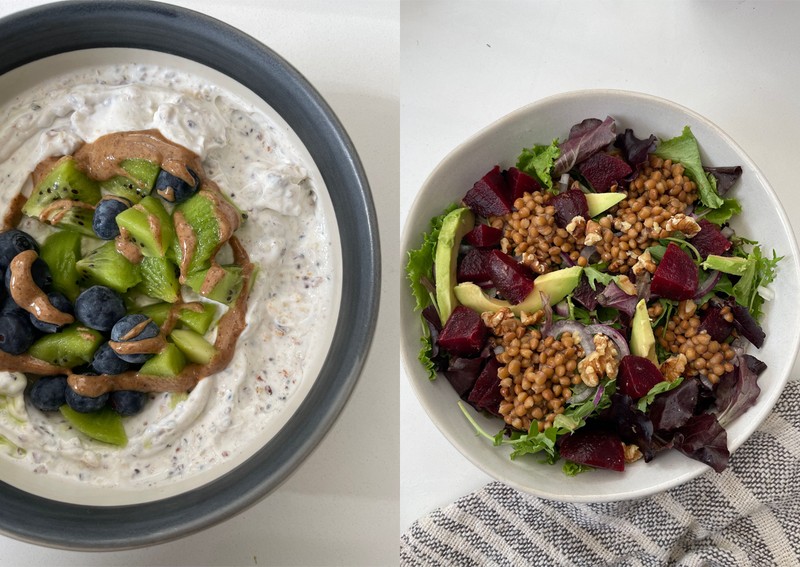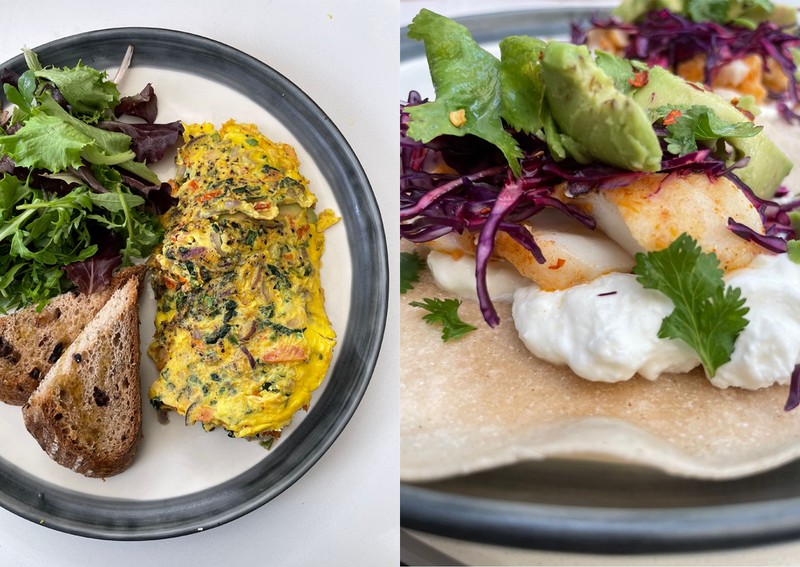What A Nutritionist Eats For Balanced Blood Sugar
I make sure my breakfast is rich in protein and fibre. My go-to breakfast is a bowl of full-fat Greek yoghurt mixed with a splash of kefir topped with jumbo oats, ground flaxseed, shelled hemp seeds, chia seeds and a scoop of collagen powder. I mix this together and top with almond butter and fruit. I’m obsessed with golden kiwis – one of the richest sources of vitamin C – as well as stewed apples, which contain calming and anti-inflammatory pectin. This breakfast is rich in protein, fibre and healthy fats to keep blood sugar stable for at least four hours, the optimal time to leave between meals for better blood sugar balance.
Jumbo oats cause less of a glucose spike. As the weather gets colder, I’ll swap my yoghurt bowl for porridge, making sure I use jumbo oats, which take longer to be broken down than instant oats. Jumbo oats, however, will still cause a sugar spike when eaten on their own, so I add chia seeds, ground flaxseed, almond butter and kefir for a slower, more stable release of sugars to support gut health, energy, concentration and hormones. At this time of the year, I often grate in a parsnip, too.
Berries are preferable to a banana. Berries are naturally low in sugar and are the only fruit you can eat on their own as a snack without impacting blood sugar. All other fruits – like apples and bananas – should be combined with nuts or seeds to slow the release of sugar into the bloodstream. I especially love blueberries as studies show they support attention and focus.
We all respond differently to low blood sugar. Most people experience sugar cravings, anxiety, irritability, feel dizzy or exhausted when their blood sugar plummets, and this is usually the point where they’ll reach for a sugary or carb-rich snack. I know immediately if my blood sugar levels are dropping. I start to get hangry, feel anxious and notice I can’t concentrate as well. I take care not to let my blood sugar drop, but if I feel I need a snack in the afternoon, I’ll have a small handful of nuts, some olives, a boiled egg, hummus and crudités, an apple with nut butter, or a smoothie made with blueberries, protein powder, chia seeds and almond milk.
If you love potatoes, let them cool before eating. When potatoes are hot, they have higher levels of glucose and starch, which gets digested quickly, spiking blood sugar. However, when you cook and cool a potato before eating it, more resistant starch forms – this is a type of fibre that mostly resists digestion, meaning it’ll absorb more slowly into the bloodstream, keeping sugar levels stable. Adding cooled potatoes to salad is an obvious solution, but you’ll also reap the benefits if you reheat the potatoes after allowing them to cool first.
How you eat matters. A new study shows chewing your food properly can lower blood sugar. This is particularly important in the evening, when the body is naturally more tired and less able to break down food. Aim to chew each mouthful 15-20 times.
If I’m eating out, I’ll start with olives and a green salad. Starting a meal with a green salad – or a small bowl of any green, non-starchy vegetable – will slow the release of sugars from everything else you eat afterwards. Ingredients like rocket will also support better digestion and absorption of nutrients. Olives are also a great appetiser if you’re eating out – they’re on most menus and by being low in carbs and rich in healthy fats, they won’t spike blood sugar
Nuts are a great snack. Small packs of nuts and seeds are great to keep in your bag and will keep you going on busy or more active days. I always carry Clearspring tamari almonds in my bag, and I’ll pick up a bag of Deliciously Ella dark chocolate almonds if I fancy something sweeter.
Keeping your cupboards well stocked is key. Beans and lentils are fantastic ingredients to have to hand as they’re rich in slow-releasing carbs as well as protein and fibre. If you’re working from home – or making a packed lunch to take to work – add them to salads, stir into soups and stews, and use them to make dips like hummus. I love adding green lentils to salads – my current obsession is a base of rocket topped with green lentils, thinly sliced onion, avocado, beetroot, crushed walnuts and balsamic vinegar.
Eggs are a fantastic and versatile protein source. When I know I have a busy week and will be short on time, I’ll boil a few eggs at the weekend and keep them in the fridge for a quick snack or to add to salads. If I’m working from home, I’ll often make an omelette for lunch. I sauté any vegetables I have in the fridge – onions, leeks, carrots, peppers, mushrooms – then add three eggs and make an omelette, serving with a side of mixed greens and a slice of toast. If you can tolerate dairy, cottage cheese is a great source of protein – I love it on sourdough toast with chopped tomatoes and black pepper.
I eat oily fish three times a week. I love salmon, mackerel, sardines and trout – all of which are anti-inflammatory. I have wild salmon or trout for dinner a couple of times a week and often buy smoked mackerel, which can be easily added to meals. Tinned wild salmon is also great – add to a salad, mash into fishcakes or use as a filling for a baked potato. For healthy meal inspo, I love Melissa Hemsley and Deliciously Ella. Most of their recipes use a variety of nutrient-dense vegetables – you can then add a protein of your choice to the side.
Apple cider vinegar often features at dinnertime. It has been shown to slow down the release of sugar into the bloodstream and support stable sugar levels. I mix one tablespoon of Willy’s apple cider vinegar with two tablespoons of Citizens of Soil extra virgin olive oil and salt and pepper, and add to vegetables and salad. I also love chamomile tea with dinner. It’s been shown to support good blood sugar levels and helps soothe the nervous system ahead of sleep.
Always put clothes on your carbs. If you do one thing to support your blood sugar, add a source of protein. If you’re eating out, order a dish with fish, chicken or tofu, and consider adding a side of mixed seasonal vegetables, like steamed greens. At special occasions, always start with savoury food – whether it’s protein or vegetables – before having something sweet. Then if you do fancy something refined or sweet, the sugar will have less of an impact. If you are going to friends or family, take a dish that will support blood sugar – I often make a big green salad with a variety of veggies and herbs.
A ten-minute walk after eating is a simple way to reduce blood sugar. Gentle movement helps shuttle sugar out of the blood and into your cells and is a useful way to prevent a post-meal energy dip. Just ten to 15 minutes is all you need to see the benefits. If you don’t fancy heading outside, squats, unloading the dishwasher or doing housework all count.
Fasting isn’t always a good idea. There are benefits to fasting, and for most women a 12-hour overnight fast works well, though you should eat within an hour of waking. But if you get hangry, irritable, light-headed or shaky when fasting for longer than 12 hours, fasting isn’t for you. These are signs your blood sugars are imbalanced and that your adrenals are struggling to maintain blood sugar.
For more nutritional advice from Farzanah, visit FarzanahNasser.com & follow @FarzanahNasser_Nutrition on Instagram
DISCLAIMER: Features published by SheerLuxe are not intended to treat, diagnose, cure or prevent any disease. Always seek the advice of your GP or another qualified healthcare provider for any questions you have regarding a medical condition, and before undertaking any diet, exercise or other health-related programme.
DISCLAIMER: We endeavour to always credit the correct original source of every image we use. If you think a credit may be incorrect, please contact us at info@sheerluxe.com.




